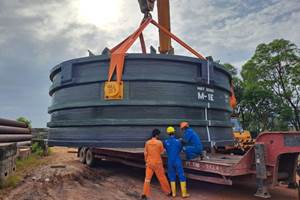Composites recycling — no more excuses
Columnist Dale Brosius outlines six actionable levels of composites recycling that fabricators should follow.
- Wind/Energy
- Sustainability
- Automotive
- Defense
- Carbon Fibers
- Out of Autoclave
- Materials
- Glass Fibers
- Pressure Vessels
- ATL/AFP
- Weaving
- Consumer
- Processes
- Epoxies
- Resins
- Thermoplastics
- Aerospace
- Mass Transit
- Reinforcements
- Markets
- Marine
- Injection/Overmolding
- Construction
- Compression Molding
- Additive Manufacturing
- Recycling
- Core
Share
In April 2016, I authored a column titled “Can we make recycled carbon fiber sexy?”. It was written after I had seen a roof panel on a BMW i8 at the North American International Auto Show in Detroit that was made from a visible, clear-coated carbon fiber mat, recovered and repurposed from cuttings in BMW’s composites manufacturing process. It demonstrated significant forward thinking at the time, as all other examples of visible carbon fiber on display at the show were woven fabrics, yielding the classic carbon fiber “look” under their clear finishes.
A lot has transpired since then, as various composites recycling technologies have matured and spawned multiple entrants. Composites recycling has also attracted investment from venture capital funds as well as strategic investors, such as Hexcel (Stamford, CT, US) taking an equity position in Carbon Conversions Inc. (Lake City, SC, US) in 2016, and the December 2018 announcement of Mitsubishi Corp. (Tokyo, Japan) taking a 25% stake in ELG Carbon Fibre Ltd. (Coseley, UK). Perhaps most significant is the growing list of end-use applications incorporating recycled composite materials, from manhole covers to park benches to materials for 3D printing, among others.
At CompositesWorld’s Carbon Fiber conference in December 2018, speakers from ELG, Vartega Inc. (Golden, CO, US) and Composite Recycling Technology Center (CRTC, Port Angeles, WA, US) presented material properties of recycled composites (which are comparable, they say, to those of virgin material) as well as already created end-use applications that could result in significant demand.
There are two main goals to recycling composites and composite materials waste: the first is to avoid placing waste in landfills, and the second, and perhaps more important, is to find ways to recover and reuse these materials in useful (and profitable) applications. But which methods achieve which objectives, and which make sense for various feedstocks? To start a dialogue around this, I propose a method to categorize the various recycling technologies on six levels:
Level 0 is minimization of scrap going to landfill, led by improving material utilization and reincorporating offal in other products inside the same composite manufacturing facility. This includes using low-waste processes like automated tape laying (ATL) and automated fiber placement (AFP) of dry fiber and prepregs, and regrinding or chopping scrap pieces and using them in combination with continuous or discontinuous materials in center layers, or injection or compression molding. It is applicable to thermosets and thermoplastics and should be a priority for all fabricators.
Level 1 is repurposing of scrap materials headed for the landfill. This includes milled, chopped and mat forms of dry fiber scrap, as well as taking uncured prepregs that may be expired or off-spec and molding them into products with less stringent performance requirements. There are numerous scrap fiber processors, and several “repurposing” entities for prepreg, such as the CRTC.
Level 2 is taking cured composites as well as scrap fiber and uncured prepreg, shredding it and combining it with additional resins to bind it all together in various panels and products replacing metal, wood and concrete. Feedstock can include end-of-life wind turbine blades, boats, airplane parts and automotive components, and can be glass fiber, carbon fiber or foam cored. Global Fiberglass Solutions Inc. (Bothell, WA, US) and GreenTex Solutions LLC (Charleston, SC, US) are two companies at this level.
In Level 3, fibers are reclaimed from intermediate product forms such as uncured thermoset and thermoplastic prepregs, yielding fibers with properties essentially equivalent to the original fibers, albeit mainly in a discontinuous “fluff” or pelletized form, or in a nonwoven format. ELG, and Carbon Conversions (both using pyrolysis) and Vartega (using solvolysis) offer carbon fibers at this level.
Recovery of fibers at Level 4 (cured composite scrap and rejected parts) and Level 5 (end-of-life parts) is the “holy grail” of composites recycling. Available technologies include high-temperature pyrolysis (ELG and Carbon Conversions), wet chemical polymer breakdown (Adherent Technologies, Albuquerque, NM, US) and a dual energy production/fiber recovery pyrolytic method developed by CHZ Technologies (Auburn, AL, US). Economic scaling of these technologies will be essential to achieving long-term success.
Given the options available, composites fabricators need to consider including recycling companies as part of the composites supply chain just like fiber, resin and prepreg suppliers. In so doing, they need to be prepared to invest R&D funds to help these evolving technologies achieve maturity. In December, Boeing announced a five-year agreement with ELG to send its composite waste, cured (Level 4) and uncured (Level 3), from 11 manufacturing sites to ELG for recovery of carbon fiber. It’s a start, and it’s time for other manufacturers to follow suit. No excuses allowed.
Related Content
Bio-based, fire-resistant composites become mainstream
Projects use Duplicor prepreg panels with highest Euroclass B fire performance without fire retardants for reduced weight, CO2 footprint in sustainable yet affordable roofs, high-rise façades and modular housing.
Read MoreComposites end markets: Infrastructure and construction (2024)
Composites are increasingly used in applications like building facades, bridges, utility poles, wastewater treatment pipes, repair solutions and more.
Read MoreNew standard specification supports non-metallic FRP rebar
ASTM International standard D8505 enables further integration of FRP rebar into infrastructure applications.
Read MoreCirculinQ: Glass fiber, recycled plastic turn paving into climate solutions
Durable, modular paving system from recycled composite filters, collects, infiltrates stormwater to reduce flooding and recharge local aquifers.
Read MoreRead Next
All-recycled, needle-punched nonwoven CFRP slashes carbon footprint of Formula 2 seat
Dallara and Tenowo collaborate to produce a race-ready Formula 2 seat using recycled carbon fiber, reducing CO2 emissions by 97.5% compared to virgin materials.
Read MoreVIDEO: High-volume processing for fiberglass components
Cannon Ergos, a company specializing in high-ton presses and equipment for composites fabrication and plastics processing, displayed automotive and industrial components at CAMX 2024.
Read MorePlant tour: Daher Shap’in TechCenter and composites production plant, Saint-Aignan-de-Grandlieu, France
Co-located R&D and production advance OOA thermosets, thermoplastics, welding, recycling and digital technologies for faster processing and certification of lighter, more sustainable composites.
Read More











.jpg;maxWidth=300;quality=90)









